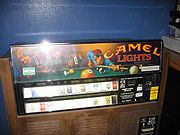
Joe Camel
Encyclopedia

Mascot
The term mascot – defined as a term for any person, animal, or object thought to bring luck – colloquially includes anything used to represent a group with a common public identity, such as a school, professional sports team, society, military unit, or brand name...
for Camel cigarettes from late 1987 to July 12, 1997, appearing in magazine advertisements, billboards, and other print media.
History
The U.S. marketingMarketing
Marketing is the process used to determine what products or services may be of interest to customers, and the strategy to use in sales, communications and business development. It generates the strategy that underlies sales techniques, business communication, and business developments...
team of R. J. Reynolds, looking for an idea to promote Camel's 75th anniversary, re-discovered Joe in the company's archives in the late 1980s.
Quote from The New York Times
The New York Times
The New York Times is an American daily newspaper founded and continuously published in New York City since 1851. The New York Times has won 106 Pulitzer Prizes, the most of any news organization...
:
Joe Camel was actually born in Europe. The caricatured camel was created in 1974 by a British artist, Billy Coulton, for a French advertising campaign that subsequently ran in other countries in the 1970s. Indeed, Mr. O'Toole recalled a visit to France many years ago during which he glimpsed Joe Camel wearing a Foreign Legion cap. The inspiration behind Mr. Price's cartoon was the camel, named Old Joe, that has appeared on all Camel packages since the brand's initial appearance in 1913.
Joe Camel first appeared in the U.S in 1988, in materials created for the 75th anniversary of the Camel brand by Trone Advertising. Trone is a mid-size agency in Greensboro, N.C., that Reynolds used on various advertising and promotional projects.
Controversy
In 1991, the Journal of the American Medical AssociationJournal of the American Medical Association
The Journal of the American Medical Association is a weekly, peer-reviewed, medical journal, published by the American Medical Association. Beginning in July 2011, the editor in chief will be Howard C. Bauchner, vice chairman of pediatrics at Boston University’s School of Medicine, replacing ...
published a study showing that by age six nearly as many children could correctly respond that "Joe Camel" was associated with cigarettes as could respond that the Disney Channel logo was associated with Mickey Mouse
Mickey Mouse
Mickey Mouse is a cartoon character created in 1928 by Walt Disney and Ub Iwerks at The Walt Disney Studio. Mickey is an anthropomorphic black mouse and typically wears red shorts, large yellow shoes, and white gloves...
, and alleged that the "Joe Camel" campaign was targeting children—despite R. J. Reynolds' contention that the campaign had been researched only among adults and was directed only at the smokers of other brands. At that time it was also estimated that 32.8% of all cigarettes sold illegally to underage buyers were Camels, up from less than one percent. Subsequently, the American Medical Association
American Medical Association
The American Medical Association , founded in 1847 and incorporated in 1897, is the largest association of medical doctors and medical students in the United States.-Scope and operations:...
asked R. J. Reynolds Nabisco to pull the campaign. R. J. Reynolds refused, and the Joe Camel Campaign continued. In 1991, Janet Mangini, a San Francisco-based attorney, brought a suit against R. J. Reynolds, challenging the company for targeting minors with its "Joe Camel" advertising campaign. In her complaint, Mangini alleged that teenage smokers accounted for US$476 million of Camel cigarette sales in 1992. When the Joe Camel advertisements started in 1988, that figure was only at US$6 million, "implicitly suggesting such advertisements have harmed a great many teenagers by luring them into
extended use of and addiction to tobacco products."
R. J. Reynolds to this day has denied Joe Camel was intended to be directed at children; the company maintains that Joe Camel's target audience was 25-49-year-old males and current Marlboro smokers. In response to the criticism, R. J. Reynolds instituted "Let's Clear the Air on Smoking", a campaign of full-page magazine advertisements consisting entirely of text, typically set in large type, denying those charges, and declaring that smoking is "an adult custom".
Internal documents produced to the court in Mangini v. R. J. Reynolds Tobacco Company, San Francisco Superior Court No. 959516, demonstrated the industry's interest in targeting children as future smokers. The importance of the youth market was illustrated in a 1974 presentation by RJR's Vice-President of Marketing who explained that the "young adult market . . . represent[s] tomorrow's cigarette business. As this 14-24 age group matures,
they will account for a key share of the total cigarette volume - for at least the next 25 years."
A 1974 memo by the R. J. Reynolds Research Department points out that capturing the young adult market is vital because "virtually all [smokers] start by the age of 25" and "most smokers begin smoking regularly and select a usual brand at or before the age of 18."
In July 1997, under pressure from the impending Mangini trial, Congress
United States Congress
The United States Congress is the bicameral legislature of the federal government of the United States, consisting of the Senate and the House of Representatives. The Congress meets in the United States Capitol in Washington, D.C....
and various public-interest groups, RJR announced it would settle out of court and voluntarily end its Joe Camel campaign. A new campaign with a more adult theme debuted: instead of Joe Camel, it had a plain image of a quadruped
Quadruped
Quadrupedalism is a form of land animal locomotion using four limbs or legs. An animal or machine that usually moves in a quadrupedal manner is known as a quadruped, meaning "four feet"...
al, non-anthropomorphic camel
Camel
A camel is an even-toed ungulate within the genus Camelus, bearing distinctive fatty deposits known as humps on its back. There are two species of camels: the dromedary or Arabian camel has a single hump, and the bactrian has two humps. Dromedaries are native to the dry desert areas of West Asia,...
. This image is still used in advertisements for Camel today. As part of the agreement, RJR also paid $10 million to San Francisco and the other California
California
California is a state located on the West Coast of the United States. It is by far the most populous U.S. state, and the third-largest by land area...
cities and counties who
intervened in the Mangini litigation. This money was earmarked primarily to fund anti-smoking efforts targeted at youth.

